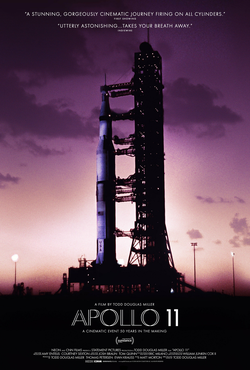Apollo 11 is directed by Todd Douglas Miller, and features a musical score by Matt Morton. This movie is not to be confused with the narrative film Apollo 13 from 1995, or First Man, a Neil Armstrong biopic from 2018.
Apollo 11 is the story of the titular space mission in July of 1969, which was the first ever landing on the Moon. The movie tells the story through a wide variety of archival footage, much of which is from the NASA vaults and has never been released to the public. The story has said footage organized in the structure of a narrative film, and does not include any narration, voiceovers, or interview footage.
There have been a ton of movies and television shows made about space travel and the various missions to outer space and the Moon. You may be wondering, given the wealth of material already available, why you should see this film.

There are actually several good reasons! The movie utilizes footage never previously seen, which isn’t limited to the expected footage of the space travel. Nothing seen visually in the film was actually created for it, aside from some retro-style animation used to illustrate some portions of the journey. The structure enables the movie to play out like something of a narrative film rather than a documentary, and the approach works surprisingly well, with the only voiceovers we hear being what’s available in the archival materials. Matt Morton’s electronic-style score was composed only with instruments available in the period of the mission, and the wealth of undiscovered footage from NASA’s vaults, in remarkably good shape, shows things from some unexpected perspectives.
What is truly remarkable about Apollo 11 is how director/editor Miller compiled and edited the raw footage from the NASA vaults into a believable narrative structure. Even if someone isn’t familiar with the mission at hand, they’ll be able to follow along despite a lack of traditional narration and contemporary interview content. Miller’s ability to achieve this goal with his audience is a testament to just how well put together it is.
The atmosphere in the film is set beautifully with the score by Matt Morton. It gives the movie an almost science fiction feel, which is appropriate given how the Moon was so far away and essentially unexplored territory in 1969. Fortunately, the score never distracts or detracts from the overall experience, instead enhancing it throughout. All we hear as far as music goes in the movie is Morton’s score, aside from a brief country tune on the way back from the Moon.
But the true highlight of Apollo 11 is the footage itself. Who would have thought there would be a treasure trove of undiscovered archival footage in NASA’s vaults unseen for half a century? Obviously, we get things like launch footage, scenes from Mission Control rooms, and spacecraft in transit. But it’s the unexpected material which shows the events unfolding from other perspectives which truly makes the movie stand out. You’ll see surprising footage of people coming out in massive numbers to watch the launch, not only from the Space Center, but also retail parking lots, hotel balconies, and beachfronts, just to catch a glimpse of history in the making (goes to show how much in today’s world we take space programs/travel for granted). We see parts of the Mission Control facilities not limited to the main rooms, including lobbies with reporting of then-contemporary events, and even the wives and children of the astronauts coming to visit. There are many photographs and pieces of footage from the moon landing itself. The “real time” nature helps it to stand out, especially compared to other docs which simply rush to the launch and don’t show any prior happenings on the launch pad. What’s truly amazing is how good of shape all the footage is in, although understandably some tends to vary in quality depending on the nature of the source material.
There has been an endless amount of content produced around the Apollo 11 mission, but this striking documentary is an instant classic and a must view for anyone who wants to learn more about the massive undertaking which remains one of humankind’s greatest landmarks. The film is playing is a frustratingly limited number of theaters, but it’s not to be missed.
Rating: Four stars out of four.
DISCLAIMER: Images in this review are the property of their respective copyright holders, including CNN Films, Neon, and Statement Pictures. All rights reserved. For promotional use only.
